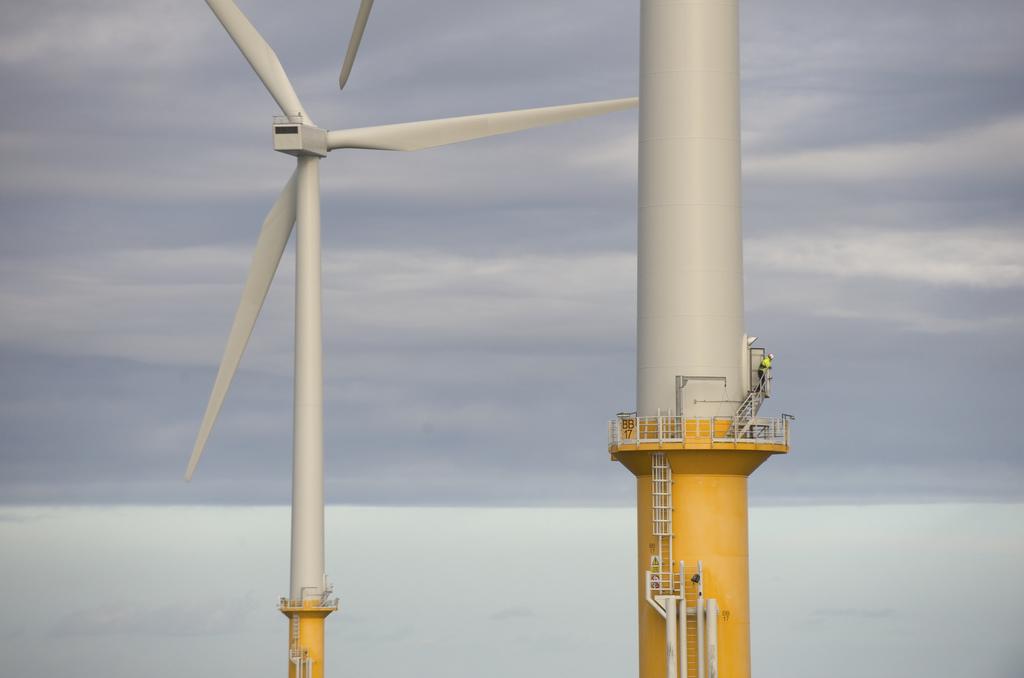
The global offshore wind market is expected to be worth more than $57 billion by 2022 and, as the Wall Street Journal reported recently, the race is on to build bigger, better turbines.
The average offshore turbine installed last year produced around 6 megawatts of power, and the offshore wind sector now generates 19 gigawatts of electricity globally—enough to power more than 13 million homes. The next symbolic and innovation benchmark for the industry is an offshore turbine capable of generating 10 megawatts of power—and top companies are gearing up to be the first across the finish line, the Journal reported.
Today’s most powerful offshore turbine —a prototype from MHI Vestas, a joint venture of Mitsubishi Heavy Industries and Danish company Vestas Wind Systems—has the potential to produce 9.5 megawatts of power and is roughly two times taller than the Statue of Liberty. German turbine company Senvion SA plans to produce a “10-plus” prototype by 2020, and General Electric teased the release of a 12-megawatt monolith earlier this year—though some are skeptical of the company’s ability to make it happen, reported Erin Ailworth of the Journal.
No matter which firm crosses the 10-megawatt threshold first, the innovation race continues to drive wind prices down significantly—which could unleash economic opportunities around the world.
The development of a typical 500-megawatt offshore wind farm requires around 2.1 million person-days of work—meaning work completed by humans rather than machines, according to the International Renewable Energy Agency (IRENA). The wind industry and related fields already employ more than 1.1 million people, in positions ranging from technicians and manufacturing workers to lawyers and consultants.
Americans make up around 10 percent of the global wind energy workforce, with over 100,000 people working in the industry at the end of last year, but data indicates we’re just scratching the surface. The U.S. has some of the best wind energy resources in the world, according to the Wind Energy Foundation. If we were to tap all of our accessible onshore and offshore wind potential, we’d produce 3.7 trillion kilowatt-hours of electricity each year—or nearly 10 times the country’s existing energy needs. Sourcing even 20 percent of our power from wind would create more than 500,000 new jobs, according to U.S. Department of Energy estimates.
Even further, the wind sector has the potential to address the pain points of hurting and displaced workers from other industries. A growing number of farmers are supplementing their income by leasing some of their land to wind power producers, and American wind farms paid $222 million annually to rural landowners as of 2016. The industry could also help prevent fossil fuel workers from being left behind in the shift to a clean-energy economy.
In Wyoming, which produces nearly half of America’s coal, Goldwind Americas is preparing to manufacture 850 turbines for a new onshore wind farm in the state. The U.S. subsidiary of Chinese wind turbine manufacturer Goldwind Global held a free two-week training last year to recruit candidates, particularly former coal miners, as technicians to service the turbines, the New York Times reported.
“If we can tap into that market and also help out folks that might be experiencing some challenges in the workforce today, I think that it can be a win-win situation,” David Halligan, chief executive of Goldwind Americas, told the Times.
Though the onshore wind market is far more developed and as such represents the bulk of wind-sector employment, fossil fuel workers may find it even easier to transition to the burgeoning offshore industry. “In offshore wind, many of the newly created jobs could be filled by labor previously employed in the fossil fuel sector,” IRENA explained in a report released earlier this year. “Offshore wind development benefits from synergies with offshore oil and gas, specifically in terms of skills and occupational patterns.”
Though the U.S. still has only one operational offshore wind farm—a five-turbine installation off the coast of Rhode Island—examples in Europe and elsewhere prove IRENA has a point. As of 2016, a third of all engineers working in the United Kingdom’s offshore wind sector had made the move from oil and gas. “By the end of the decade we expect the UK’s offshore wind sector to double in size,” Maf Smith, deputy chief executive for the UK’s largest nonprofit renewable energy trade association, RenewableUK, told the Telegraph. “So the UK is perfectly placed to take advantage of its 40 years of offshore expertise, with workers making the transition from fossil fuels into renewables.”
In Canada, Iron and Earth—an organization founded by oil sands workers—is out to retool their colleagues for the clean power sector. Last year, it partnered with offshore wind developer Beothuk Energy to retrain oil and gas workers for employment in six new offshore wind farms. “When the labor market recognizes a global shift, and becomes a first mover, it sends a strong signal to Canadians, to government, to industry. It’s a movement from blue-collar to green-collar,” Kirby Mercer, chairman and CEO of Beothuk, said in a statement.
Examples like these are encouraging, though challenges remain—even in the UK, the world’s leading offshore wind power producer, oil and gas workers are complaining that red tape makes it harder for them to transition to wind. Yet IRENA predicts the current segment is only the tip of the iceberg—projecting cumulative investments in offshore wind to reach $350 billion by 2030 and nearly $1.5 trillion by 2050.
“As the offshore wind energy sector grows, it offers greater opportunities for individuals and businesses from the offshore oil and gas sector in different segments of the offshore wind value chain,” the organization says.
Image credit: The Danish Wind Energy Association/Flickr
Editor's note: An earlier version of this article referenced Vestas Wind Systems as a Dutch company. We regret the error.

Mary has reported on sustainability and social impact for over a decade and now serves as executive editor of TriplePundit. She is also the general manager of TriplePundit's Brand Studio, which has worked with dozens of organizations on sustainability storytelling, and VP of content for TriplePundit's parent company 3BL.














